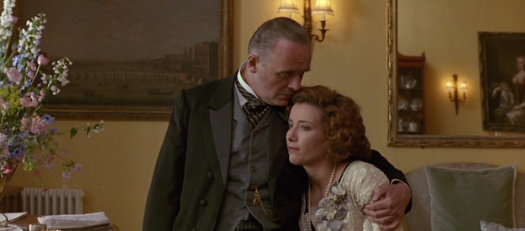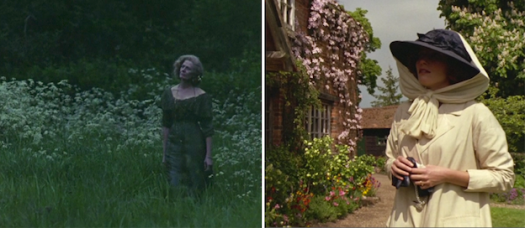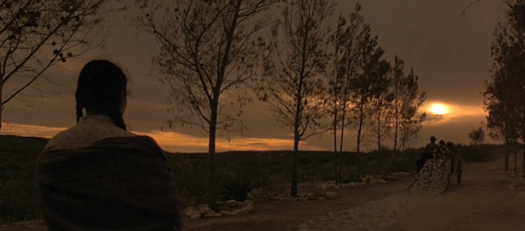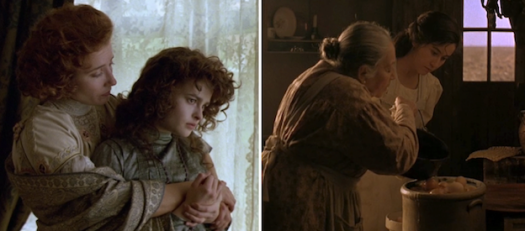Welcome back to Summer of 92, the summer series in which I take a look at the movies released in 1992, also known as the year I was born. If you want an overview of what I’ve covered so far, you can click HERE. Otherwise, keep reading.
Now let’s talk about literary adaptations of period costume dramas, a genre that I’ve always been interested in. The reason why is not entirely clear to me, except for two very personal theories. The first, is that one of my biggest obsessions in the years when I was becoming a film fan (and one that continues today, although not as obsessively) was the Academy Awards aka the Oscars, and as you might know, period literary adaptations are one of Oscar’s favorite genres. The other is that, also back when I was a young film lover, few phrases made me angrier than when someone said “the book is better than the movie.” As someone who considers film to be the most fascinating of life’s art-forms, and someone who has a hard time finding enjoyment in reading fiction books, I’ve always been a proponent of film adaptations being reinterpretations of re-imaginings than adaptation per se. The further a movie skews from the book it’s based on, the more interesting I’m going to be in watching it. That is also why I’ve always found the Harry Potter movies to be incredibly mediocre. More of a translation of the books they’re based on than a product of actual cinema. But Harry Potter isn’t today’s topic, and has little to do with either of the movies that I’ll be writing about, except in the fact that it shares a country of origin, and a couple cast members, with Howards End.
Now, Howards End is the product of a cinematic collaboration that could be described as a genre of its own: Indian producer Ismail Merchant, British director James Ivory, and German screenwriter Ruth Prawler Jhabvala. In the early nineties, the peak of the collaborators’ popularity, Merchant-Ivory became a shorthand for a very specific type of movies: literary adaptations, mostly of english novels, that featured outstanding acting and top-notch production values; a type of movie that young cinephiles, including yours truly, would describe as “boring.” The fact that these movies operate on a genre that is, almost by definition, unexciting to young straight men, has hurt their legacy in a landscape dominated by IMDb user-ratings and comic book adaptations. Those who were critical of Merchant-Ivory’s cinema, at least those who were smarter than my younger self, complained about these movies in the exact way I complain about Harry Potter, describing them as well-acted translations of well-respected stories that lack any kind of urgency or reason for having been adapted to the screen. The other development that has hurt Merchant-Ivory’s reputation tremendously, is the fact that their success sparked a wave of lesser imitators, and that virtually all literary adaptations or similar period pieces are now produced in the image of their work. However, any right thinking person would recognize that there is an ocean of difference in quality between Finding Neverland and Howards End.
I haven’t read the material Howards End is based on -the eponymous novel by E.M. Forster- so I don’t know if there any major differences or traces of a personal interpretation of the material in the movie. What I do know is that James Ivory could be a fantastic director when he wanted to, and that he did an outstanding job directing Howards End. Without indulging in any kind of stylistic departure that would have distances Howards End from what people traditionally think of as a Merchant-Ivory movie, his shooting is in service of the movies and the characters in a way that exposes the weakness of its imitators. Consider, for example, how, unlike many contemporary directors, he isn’t afraid of staging conversations featuring more than one character in the frame instead of a dull shot/reverse-shot setting. If he does feature a shot/reverse-shot conversation in the movie, it’s because the cutting has thematic significance, as in a key moment where the characters played by Anthony Hopkins and Emma Thompson find out their values stand in opposition to each other’s. For the most part, characters share the screen, and interact with each other in configurations that take into account both the width and the depth of the frame.

Very few of the visuals, of course, call attention to themselves. The most important goal of the filmmakers was, without a doubt, to highlight the power of the story that was being told. Since it was so important, let me talk a little bit about it. The film is mostly concerned with the relationship between two families: the Wilcoxes, which are rather wealthy, and the Schlegels, who are upper middle class. Now, the Wilcox patriarch is the deeply traditional Henry (Anthony Hopkins). The most important Schlegels in the movie, on the other hand, are a pair of orphaned sisters, Margaret (Emma Thompson) and Helen (Helan Bonham Carter), who have a fairly liberal sense of thinking, expressed in their extroverted personalities and the fact that they are interested in women’s suffrage. The movie opens in one of the Wilcoxes’s properties, Howards End, with an embarrassing incident involving Helen and the Wilcoxes. We then jump in time to the Wilcoxes moving across from the Schelgel girls’ London apartment. That’s when Margaret and Henry’s wife Ruth Wilcox (Vanessa Redgrave) bond and develop a tight friendship. The relationship between Margaret and Ruth is one of the most important elements of Howards End. This is a perfect example of Ivory understanding precisely where the heart of his movie lied, and working in its favor. The actresses’ work is fantastic, with Emma Thompson being as delightful as only she can be, and Vanessa Redgrave playing a character that is pretty much the political antithesis of herself as an incredibly fragile and delicate human being.
If I’m being completely honest, the fact remains that Howards End is a little too literary a movie. It might be a product of the time and circumstances it was made in, but like many literary adaptations, it is not entirely confident to let its themes be expressed solely through images. It feels the need to also express them through words, but these moments are actually relatively few and far between, and most of the movie unfolds with remarkable elegance. There is, for example, the key moment in which Margaret finally visits Howards End, and even though a housekeeper remarks how she looks like Mrs. Wilcox, we have already made the connection thanks to the way she is filmed when she enters the house’s garden. The scene is a callback of the opening sequence, in which we see Ruth Wilcox walking around the gardens of Howards End, and yet, the scene featuring Margaret is shot from the reverse angle as Ruth’s, and under completely different lighting. It doesn’t recall the previous scene through imitation, but by complementing it. It doesn’t work as a mirror, but as a puzzle piece you didn’t know was missing.

Not all moments in Howards End are as elegant as that one -in fact, an important development late in the movie features some uncharacteristically overdramatic and narratively cheap slow-motion- but there is no denying that its best moments show a level of craftsmanship that isn’t regularly featured in movies that fit so well into a pre-established genre mold as Howards End does. So many of its imitators were content with building pretty sets and pointing the camera at their actors, but there is an actual vision being served in Howards End. What’s more, beneath its flawlessly pretty exterior, Howards End is a much more visceral, even angry, movie that you would have expect considering its English upper class setting. One of the most important themes of Howards End is the hypocrisy of those in power, especially against the poor, and against women. I didn’t really talk about the subplot that focuses on Helena Bonham Carter’s character, or on Samuel West’s Leonard Bast, but the way these two characters reflect on the relationship between Maragaret and Henry Wilcox is essential to the movie’s message. The movie’s elegance actually works to reveal how easily and casually the privileged can impose cruelty on the weak. The fact that Howards End’s screaming heart is trapped beneath a seemingly decent and quiet movie echoes the situation of its characters, and its message, which is sadly as relevant today as it was back then.
But before this turns into a never-ending rave of Howards End, let me remind you that this series is dedicated to double features, and that the other movie I saw this week was Alfonso Arau’s Like Water for Chocolate (Como agua para chocolate), another literary adaptation -this time of a novel that I have actually read- but one that shows many of the weaknesses and mistakes that tend to be committed by unsuccessful adaptations. The movie is based on the novel of the same name by Mexican author Laura Esquivel. The novel fits in the very Latin American genre of stories about ancestors featuring lots of magic realism elements. Now, if you know about Latin American literature, then you probably know that particular brand of magic realism is incredibly difficult to translate correctly to the big screen (see: The House of the Spirits or Love in the Time of Cholera). Many times I heard that Like Water for Chocolate was the rare magic realism novel that made for a good adaptation. Having now seen the film on its entirety for the first time, I have to say that whoever said that was wrong.
I knew there were going to be some problems with the movie as soon as the credits started rolling and revealed that the movie’s screenplay had been written by Esquivel herself. Now, there are some literary authors who can effortlessly transition to writing for film, but I think it’s fair to say that it isn’t a good idea to have a writer adapt his or her own novel to the screen, especially if you want the adaptation to be more than a way to try to put the novel on the screen. It’s pretty obvious that film and prose are two different mediums, whose strengths lie on different elements, and if there was going to be a successful adaptation of Like Water for Chocolate, it would’ve required a group of filmmakers willing to ditch the novel’s structure, and come up with a film equivalent. You see, the novel is built almost like a cookbook, in which each recipe reveals part of the story of the narrator’s great aunt Tita, who had the unfortunate fate of being the youngest of her sisters, and thus, was prohibited of marrying in order to care for her mother until her death. Sadly, the filmmakers weren’t willing to make too many changes (those are the fears that come when you are adapting a largely beloved novel).

The movie isn’t structured like a cookbook, but we can find its first mistake in the fact that it retains the narrator. Now, I am mostly against narrators in movies, but they can be used well. The narrator of Like Water for Chocolate is a horrible idea because she ends up quoting large chunks of Esquivel’s prose to explain everything that is going on, and forgetting how “show don’t tell” is one of the most effective mantas when making a movie. Rare is the scene in Like Water for Chocolate in which we can see what the characters are feelings instead of listening to the narrator explaining it to us. All in all it seems like the biggest problem with the movie was Esquivel’s unfamiliarity with the inner workings of the cinematic medium. You can tell by the dialogue (if you are a spanish speaker), which I assume was lifted largely from the book (my memory of it is hazy), because it is filled with the kind of phrasing that works on the page, but sounds ridiculous when said aloud by an actor. Similarly, one-dimensional characters that work because of the anecdotal nature of the novel’s narrator, which makes them feel like ideas more than actual human beings, fail horribly when they have the real face and body of a human actor. This is what happens to Mamá Elena, Tita’s mother, who is basically cardboard villain whose only purpose is to be bad to Tita.
The most memorable moments of the novel are those in which the magical realism comes into play. There is a particularly cute scene in which a heartbroken Tita’s tears fall into the batter of her sister’s wedding cake, which makes everyone who eats the cake at the wedding start crying incessantly. These kinds of moments are ruined in the film by a number of factors. First, because they lose the ambiguity magical realism features on the page. Second, because the freaking narrator won’t stop quoting from Esquivel’s novel. Listen, those are good parts of the book, but if I wanted to hear those pretty words, I would read it again, not watch the movie. What’s more, the filmmaking does absolutely nothing to curve the material’s limitations. As a matter of fact, some of the magical realism sequences are filmed in such an uneventful way that you wouldn’t know anything was happening if the narrator weren’t telling us so. This is an especially fatal blow during the few attempts that are made to humanize the Mamá Elena character, which barely hint at what might have made her such an joyless woman.
To close out, I just want to say that there is no reason why Like Water for Chocolate couldn’t have made a good movie. In fact, I believe an interesting movie can be made out of any novel (it just depends on the level of changes you do to the adaptation). The biggest flaw of this one, is that the movie sticks to close to the source material, sometimes literally translating it into the screen, instead of letting magical images speak for themselves. Case in point, my favorite part of the movie is the fact that Tita has an incredibly long blanket. Why she has it, or why it is so long is never explained. It is just there. It just happens in the way that magical realism just happens when you read it in a book. That’s the matter-of-factness that this adaptation needed, and that the filmmakers couldn’t give it.

Next Week’s Double Feature: Nothing! Well, not exactly. Next week will be time to talk about the television of 1992, and the week after that we’ll be discussing The Crying Game and Malcolm X.


Interesting to have stumbled upon this review. I absolutely love Howards End both book and movie. What I love most about it is there are no heroes or villains. Everyone is doing the right thing from their point of view and yet the other people are also villains from their point of view. It is such a rich movie with character arcs from what would be minor characters in other stories. It’s beautifully made and never leaves me without a thoughtful response. You should read the book. It’s really good also.